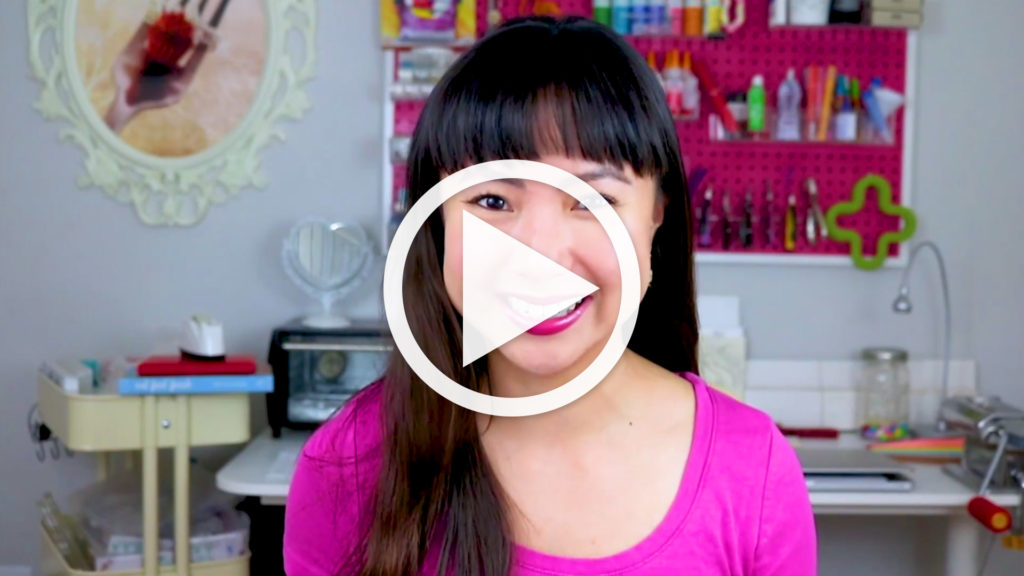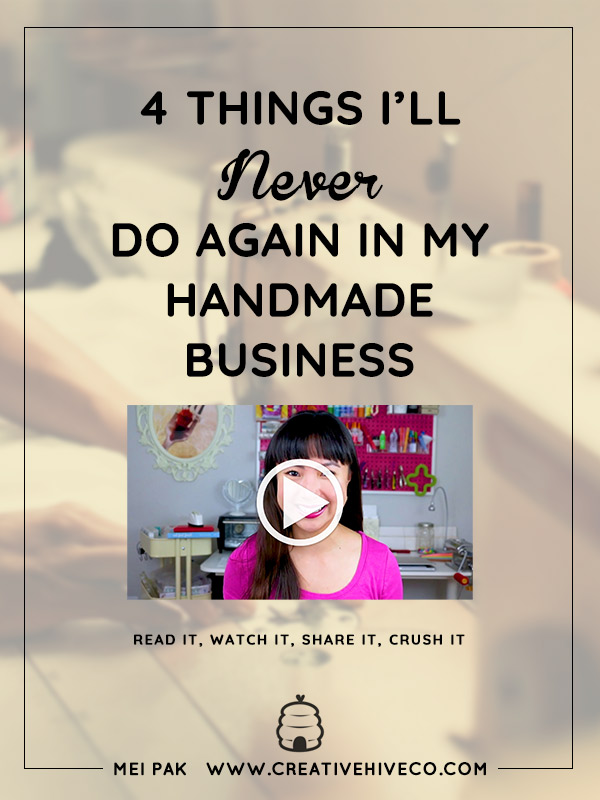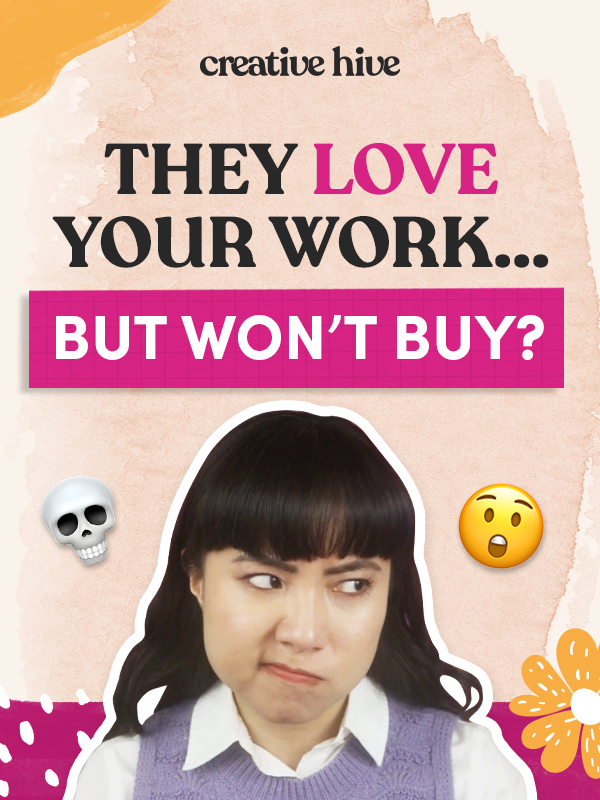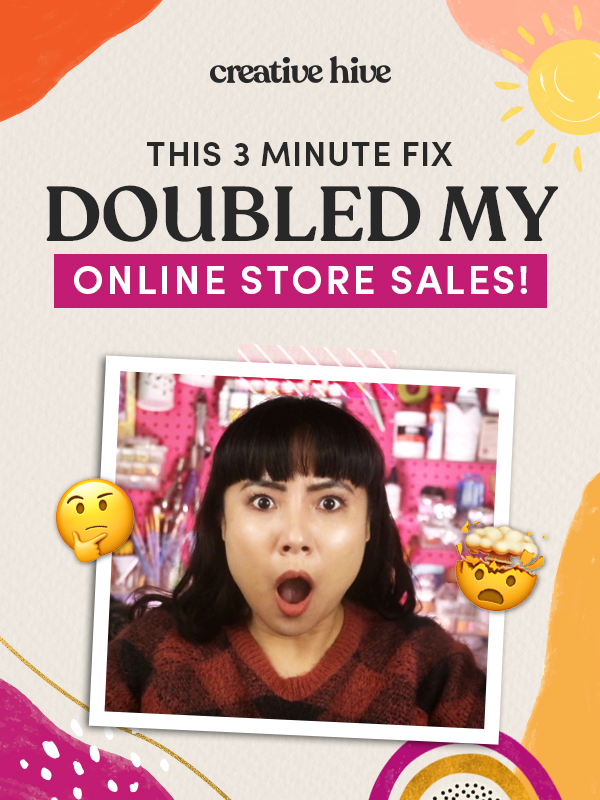I want to help you build a sustainable, profitable handmade business that makes you consistent income and sales. I only ever teach or recommend marketing, social media, pricing, production and branding tips that I’ve personally used successfully in my own 7-figure handmade businesses.
I'm Mei, from Los Angeles!
Read More
Popular Posts You'll Love
Looking for something?
Categories
starting a business
get more traffic
running a business
make more sales
branding
growing a business
mindset & productivity
podcasts
pricing & money
product photography
reviews
selling on etsy
selling on amazon
social media
selling wholesale
- Facebook8
- Twitter0
- Pinterest6
- 14shares
These aren’t things I regret doing, because I don’t! If I had never done them, I would never have known they aren’t things I want to do again in my business.
Having said that, here are the 4 things I’ll never do again in my handmade business.
I’ve been in business myself, selling my own handmade jewelry at tinyhandsonline.com for more than a decade. So I can guarantee you that I’ve tried almost everything that a business owner can do for their physical product business.
1. Craft Shows
One of the things that I’ll never do again in my business is craft shows.
Don’t get me wrong, craft shows are perfect for most makers just starting out. I actually recommend that if you’ve never sold your product before and if there are good shows and events near you, that you definitely try your hand at doing a few craft shows.
They’re a really great place for you to validate your products, to see if a total stranger would pay you money for what you make. That’s the best kind of validation to have. No amount of family and friends who tell you how amazing your products are, can ever replace having a total stranger pay you for your work.
I’ve also seen it be a great place to get feedback on your products; what’s working and what’s not. All of these things can be really useful information to have when you’re working on building up your online side of your business.
I did a ton of craft shows since I started Tiny Hands. Even when I was still in college, living with my family back in Malaysia. I remember once when I had such a terrible day, there was no traffic and I made no sales, my dad was so supportive that when he came to pick me up after the day was over, he had seen how hard I was working and he ended up taking me out to a nice dinner, just the two of us.
Anyway, if you’ve done shows, farmer’s markets, art shows, festivals and so on, you know the life.
Shows take up so much time and energy and there’s never a guarantee that you’ll be profitable.
Some people I’ve read recommend that you should make 2 to 4 times back your booth fee. If you don’t, it wasn’t a good enough show to keep doing again.
Honestly, if you sat down and calculated all the costs it took you to do a show, it very rarely ended up being profitable for me.
Let me give you a great example.
I lived in Minneapolis for many years, and for a couple of years, I applied to get into Renegade Craft Fair.
They have one in Chicago, and if you’re not familiar or haven’t heard of Renegade, it’s a very big, very sought after, in demand craft show. It’s juried and it always brings in an amazing roster of vendors and lots of foot traffic as well.
I paid $500 for my booth fee. I made about $2,000 over the weekend I did the show. This sounds great, but let’s start counting all the extra costs and work that had to go into doing the show.
- I had to pay for accommodation because I wasn’t from Chicago
- I paid for gas round trip driving from Minneapolis to Chicago
- I had my husband and my mom help me out over the weekend. So that’s three people total whose time I needed to help me man my booth. That time isn’t free, especially when there are other, better things, higher ROI things that you can do with that time
- I had to pay for food and drink for all three of us over two days
- I had to pay for parking, toll fees, wear and tear on your car
- Not to mention all the extra hours I put in to make inventory leading up to the show and you know you don’t sell 100% of everything you made
Finally, this is something very few craft show people consider, but you have to count the cost of goods sold. Just because we made $2,000 in sales that weekend, minus the booth fee of $500, doesn’t mean we made a profit of $1,500.
If we sold 100 pieces of jewelry to make that $2,000, and let’s say our cost to make 1 piece is $5, that’s another $500 that’s pure cost to pay for materials and supplies and the time it took to make those products.
Now we’re left with $1,000 in profit and I haven’t even deducted the expenses for all the other things I just mentioned.
I would be surprised if I had $500 left over of profit from that show.
And that was a good show.
I’ve done my fair share of summer shows, shows where the organizers didn’t invest enough resources into marketing the show, where there was hardly any traffic and where I didn’t even make enough money to cover my booth fee.
Doing craft shows can be a huge risk especially when you haven’t done them before.
There was actually even one show I did that was great the first year, but the second year they put me right next to the band, the entertainment for live music that they had.
I thought that would’ve been a good thing, because the spotlight would be on me, right?
Nope.
No one wanted to come close to my booth because it was so loud, and I could barely talk to my customers.
It’s hard to find good craft shows, and you can never really know if it’s good until you try it for yourself. There are so many variables and so much that’s out of your control.
I became a lot more selective with what shows I did and even stopped them altogether when I started to see that I had created other streams of income elsewhere that was paying me better money than craft shows.
When I wasn’t doing shows, I was spending my time building up my online business. I could make more money sitting on my butt in my pajamas drinking hot chocolate in the comfort of my own home, with Gilmore Girls playing in the background, than I could hauling myself out in the freezing Minnesota winters making it to a show.
Trade Shows
I also want to address trade shows which are shows specifically for buying and selling wholesale.
They’re not the same as craft shows, yet they have the same value to me at this point, where it’s very expensive to do and you get a very low return on your investment compared to other streams of income that I get.
2. Paying for SEO Services
At some point in your business, you might consider hiring an SEO service professional to do SEO work on your site or on your Etsy shop.
I have done this at least 3 or 4 times myself and here’s my experience: It’s never a good return on investment and I believe that’s because there’s the inherent problem that most SEO people don’t know your products and your customers the way that you know them.
It’s likely they’ll make keyword suggestions for you that aren’t aligned with the types of people buying your products.
I’m not saying you shouldn’t concern yourself with SEO, but it’s just that I think it’s better that you learn to do it yourself first than to hire someone to do it for you.
In fact, I will say this about anything and everything in your business.
When it comes to doing social media, pitching your products, selling wholesale, doing paid advertising: always learn how to do it yourself first before you outsource it.
SEO is a long term game. A problem with hiring out for it is you won’t see a return on your investment until much later, assuming it was done right to begin with.
I would rather spend my money on other kinds of services like a paid advertising manager or an assistant to help me write pitches to magazine editors. Those are things that I can more directly see faster money in and money out.
SEO also takes very long to get any form of feedback that you’re doing it right.
When you hire someone to do keyword research and optimize your product listings for you, you won’t know how good or bad of a job they did until months or years later.
I’m not saying you should never ever hire a professional to do SEO for you, but that there is other low hanging fruit in your business that you can take advantage of and that your money is better spent on initially before spending that money on SEO.

3. Taking Custom Orders
Like craft shows, it’s good to do if you’re just starting out.
I’ve had some amazing experiences with custom work in the beginning of my business when it started to take off and I didn’t have a full-blown product line yet. I would get emails from people asking me to make specific things that I didn’t have in my shop yet.
This is great feedback to have because if multiple people are asking for something, you can bet that more people out there will want that same thing.
It’s definitely smart to make something that’s in demand because it’ll be easier for you to make sales.
Some of my bestselling products now are because of custom orders.
I stopped doing custom orders because I could never charge as much I really needed to.
Custom orders, for me, take anywhere from 2 to 4 weeks of non-stop work. I spend a lot of time testing colors and matching clay colors with the real food that I was asked to make.
The trick is, polymer clay (which is what I use to make my jewelry) is a different color before and after it’s been cured in the oven.
Then there’s finding the right textures for sculpting the piece and finding the right fragrance or essential oil.
All my jewelry is scented, so they all smell like what they look like, but not all fragrance oils are created equal. Some can smell really chemical-y, some just don’t smell realistic enough.
The entire process takes a long time.
When people ask for a custom piece, they don’t realize all that work that goes into designing something new. They expect to pay around the same price as what they see in my online shop, which is $20 – $30 for a necklace.
I cannot charge $20 for a custom order that took me 3 weeks to make. If I did, I would be broke and homeless and I wouldn’t be talking to you here today.
So, what do I do instead?
Well, right now, if it’s a simple enough modification to an existing design, we can certainly do that.
For example, I make a waffle necklace that’s got some butter on top. If someone asked us to remove the butter, that would be no problem at all.
We do take it on a case by case basis, depending on what the customer wants.
For totally new designs, I now tell people that I am happy to do a custom design for them, but that I require a minimum amount of 100 pieces of that design for it to be worth my time.
This turns most people off unless it’s a brick and mortar or online brand that wants to resell this custom design to their own audience.
This is my “nice” way of saying yes, but no.

4. Blogging
Blogging was hugely instrumental with Creative Hive, which is this business that we’re on now where I’m sharing with you marketing tips for your own business.
But let me set the record straight.
Blogging is only really good for people who are in the space of education, if your business has some element of education in it, or if you’re a service provider or coach.
If you sell a physical product like clothing or jewelry or candles, it’s really hard to make blogging work for you.
I used to blog a lot for my jewelry business and I even hired a virtual assistant to write blog posts for me too.
I went all in.
I did blog posts featuring other cool food-related products, recipes, how to style or wear my jewelry along with outfit inspiration posts.
While I did get some traffic from it, that traffic hardly converted into sales. It’s not because I didn’t funnel that traffic over to my shop. With every blog post I wrote, I always made sure that we reconnected it back to one of my products somehow and my blog was sitting directly in my website, not on a separate domain name where it was difficult for people to come over to my shop.
Ultimately, it just ended up being a marketing strategy that had very low ROI and there are other, better marketing I could do that was more profitable.
Unless you’re naturally a great writer or you love writing, I don’t usually suggest physical product business owners take on blogging.
It’s time-consuming to do the writing itself, but more than that, you also now need to promote your blog posts if you want traffic and people to come over to read those blog posts.
If you’re already spending the time to promote something, why promote the blog post links to your products, when you can just directly promote the product and shorten that process and save you time.
The people out there who are telling you to blog, are people who are talking to coaches and service providers.
As I mentioned before, you might be able to consider blogging if you have some sort of educational element to your business. Say you make skincare, or say you make children’s clothing, and you want to share with your audience everything you know about raising a family.
Most of us have products where we can’t naturally do that in a way that serves our customers first.
I would say, don’t even concern yourself with blogging for now.

Leave a Comment
Liked this article? Share it!
Unlock a Profitable Handmade Business
in Just 12 Weeks Without Using Etsy
or Social Media
FREE WORKSHOP
This workshop is for anyone who makes and sells a handmade or physical product, including jewelry designers, artists, paper designers, bath & body product makers and more!
What You'll Discover
The #1 mistake people make with Etsy & social media that causes shops to FLOP
The secret to making it with your handmade shop so it's no longer just a hobby
How to make sales in your handmade shop with ease so you can finally get to 6-figures
TAKE ME THERE
Your email address will not be published. Required fields are marked *
Leave a Reply Cancel reply
About
Blog
A Sale A Day
Student Login
Free Class
Contact
Terms
Become A Student
Watch On YouTube
Student Reviews
See My Handmade Shop!



I completely agree with everything you just said.
I started out doing craft shows in the 90s to help pay for incidental expenses. There was no way that would be a way to make a full-time income. A lot of the sellers admitted to me they charged their supplies to credit cards and then hit the bills from their husbands! Another admitted to me you never really make back what you spent. It’s just for fun.
I’ve been taking on custom orders and that is the way I got my number one best selling product, the zipper toaster cover. I didn’t want to make those. But when I got more than five requests for that type of toaster cover and a customer decided to cancel their order for a traditional toaster cover because it didn’t have a zipper , it’s time to figure it out!
I agree custom orders in general are way too time consuming . I didn’t see any profit in it. It was cash flow. And I did form some valuable relationships for having done it . That’s the most I can say for custom.
I also learned to streamline the custom ordering process after a customer asked so many questions that she and I broke the Etsy conversations. So I can up with a questionnaire and also an explaination of my process.
If someone thinks I’m going to create an entire new design for them that’s where I have to decline. My time and sanity can’t take that anymore.